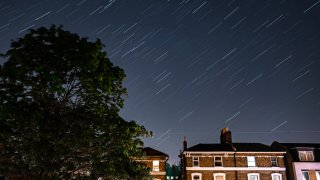
If you like shooting stars, you're in luck. The annual Lyrid meteor shower, which is active from April 16 to April 25, is expected to peak late Tuesday night and into early Wednesday morning.
Observers in the Northern Hemisphere can expect to see 10 to 20 meteors per hour during the shower — weather-permitting — with maximum activity expected to occur around 2 a.m. EDT, according to the Observer's Handbook of the Royal Astronomical Society of Canada.
Visibility will be best for skywatchers in areas far from sources of light and buildings or other possible obstructions, according to Space.com.
"Lyrid meteors will appear to originate from a point in the sky on the border between the constellations Hercules and Lyra (home of the bright star Vega)," said Space.com's Hanneke Weitering. "This apparent point of origin, known as the meteor shower's radiant, will be in the northeast after sunset and almost directly overhead in the hours before dawn."
The Lyrids aren't as spectacular as the Perseids, which return each August. But with the first recorded sighting of the Lyrids going all the way back to 687 B.C., they're the oldest known meteor shower.

